![]() The Orchards Path
The Orchards Path
What Is A Community Orchard?
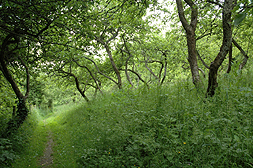

An orchard is a collection of fruit trees – mixing fruit trees with other kinds of trees profoundly changes and diminishes the feeling of orchardness. Traditional orchards – with tall standard trees, planted among grass full of wild flowers – constitute places of tranquility, places where you can find continuity in the landscape.
Community Orchards should be open and accessible at all times. They may be owned or leased for or by the community (or held by agreement) by a community group, parish council, or by a local authority or voluntary body. As well as enjoying the place, local people can share the harvest or profit from its sale, taking responsibility for any work in the orchard.
Because their prime purpose is not the production of fruit, we have the opportunity to think creatively about what these orchards can and should be like.
In Wild Fruits, the 19th-century naturalist Henry David Thoreau celebrated the special feel of rambling orchards. He described how he loved ‘to go through the old orchards of ungrafted apple trees, at whatever season of the year – so irregularly planted: sometimes two trees standing close together; the rows so devious that you would think that they not only had grown while the owner was sleeping, but had been set out by him in a somnambulic state. The rows of grafted fruit will never tempt me to wander amid them like these.’ Most of us prefer rambling old orchards – the ones with trees at all angles, even drunkenly on their sides – to the manicured and regimented ones. In 1790, a single perry pear at Holme Lacy, on the banks of the River Wye, covered a third of a hectare (three quarters of an acre) and produced 5-7 tonnes of fruit. It dropped its limbs, which rooted to produce new trees, and so spread outwards. This is the way that some fruit trees would propagate themselves, if left alone. They seldom are.

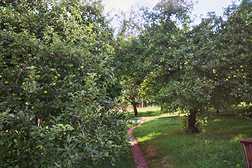
Community Orchards offer great potential in both town and country. They can work in housing estates, industrial estates, hospitals and schools. They can enliven the curriculum, improve our diet, and even speed the recovery of the ill and infirm.
The success of a Community Orchard lies in the strength of local commitment to it. Local people are the key to running it and deciding how it is used. These orchards do not have economic fruit production as their raison d’être, yet they might just pay for themselves, with income generated through the sale of fruit and other produce – everything from wild flower seeds to mistletoe. In the longer term, fruit wood, as well as coppiced hazel, could generate healthy returns.
Wild life may benefit too. The natural bounty of traditional orchards, with standard trees skirted by hedges and unimproved grassland, is increasingly celebrated by national agencies and local enthusiasts alike.
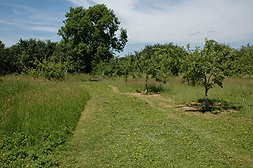
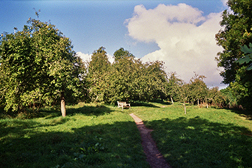
When establishing a Community Orchard, priority must go to conserving traditional orchards where they exist, as we are losing them so quickly. If you hear that a traditional orchard near you is in danger of being grubbed up, let the owner know of its importance to the landscape, to you and to the local community, that there are grants for maintenance and that there are many ways of adding value to the fruit and the orchard itself – for instance, by letting it out for grazing, local festivals, plays or to campers and caravanners.
Help in picking the fruit, cutting and removing the hay, staking, fencing and pruning can be offered in return for local access. In many cases, all an old orchard will need is ‘gapping up’ – planting new trees to replace ones that are dead or diseased. Try not to be overzealous: many fruit trees bear well lying on their sides and make excellent seats, and you can ruin the feel of the place by being too tidy or making woodchip paths. It’s worth remembering that stag beetles and a host of other remarkable insects rely on old, decaying fruit wood to survive.
If the owner wishes to sell the orchard, find out if your parishor district / borough council is willing to purchase it for the community. Alternatively, think about setting up a trust to purchase the orchard on behalf of the community or ask your county Wildlife Trust, the RSPB or the Woodland Trust if they would consider buying it.
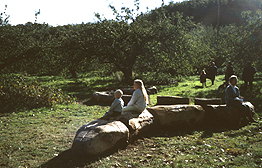
Community Orchards should be the focal point for community activities and events which could include:-
![]() Celebrating Apple Day on 21 October.
Celebrating Apple Day on 21 October.
![]() Open air plays, storytelling, poetry, meetings
Open air plays, storytelling, poetry, meetings
![]() Picnics and great feasts.
Picnics and great feasts.
![]() Climbing and scrumping.
Climbing and scrumping.
![]() Open-air classroom.
Open-air classroom.
![]() Beekeeping.
Beekeeping.
![]() Festivals such as May Day and Wassailing.
Festivals such as May Day and Wassailing.
![]() Picking and tastings.
Picking and tastings.
![]() Pruning and grafting days.
Pruning and grafting days.
![]() Community wild life observances.
Community wild life observances.
If you have a Community Orchard, please let us know -
email info [at] commonground.org.uk.